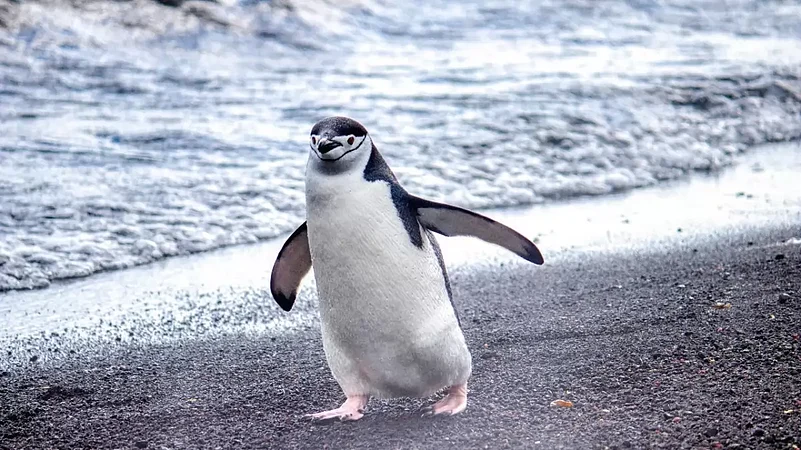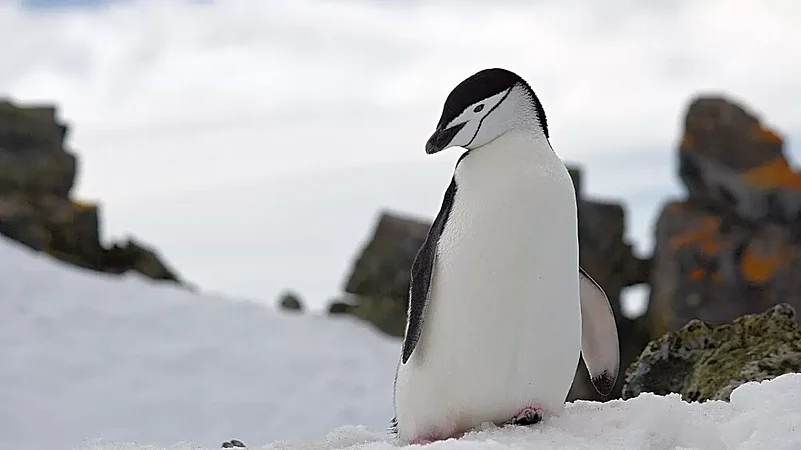Every year, along the ice-free Antarctic coastline, millions of chinstrap penguins gather to create bustling breeding colonies. These colonies - chaotic, noisy and, yes, smelly - every year, lay eggs in November that hatch in late December and January.
For these medium-sized penguins, safeguarding their nests is a critical task, especially with brown skuas, predatory seabirds, on the prowl. Falling asleep during their watch could prove disastrous for both the eggs and later the chicks. However, scientists revealed on Thursday that this species has ingeniously found a way to ensure an adequate amount of sleep without compromising their vigilance.
The scientists observed extreme sleep patterns in these flightless creatures. Instead of having extended sleep sessions during the nesting period, chinstrap penguins take short naps throughout the day—approximately four seconds each—and fulfill their sleep requirements cumulatively, accumulating about 11 hours per day. Unlike humans, they don't view sleeping in short four-second intervals as torture, but rather as a natural rhythm, according to the research. They engage in this pattern of brief naps thousands of times throughout the day.
"They show an unexpected sleep adaptation, a tradeoff between the need to sleep and the need to be awake," said ecophysiologist Paul-Antoine Libourel of the Lyon Neuroscience Research Centre in France, lead author of the research published in the journal Science. “Sleep is much more complex in its diversity than what we read about in most textbooks.”, he added.
Collecting information from 14 penguins tending to their eggs in a colony of around 3,000 breeding pairs on Antarctica's King George Island in December 2019, the researchers employed electroencephalography to measure brain electrical activity, indicating sleep patterns. Additionally, they recorded videos of the birds and utilized various bio-logging devices, including GPS monitors and accelerometers, to monitor their location and body movements.
Researchers previously looked at penguin sleep in the 1980s, which involved capturing them, placing them in a shelter, and observing their behavior. During that study, they noted fragmented sleep in short intervals, referred to as "drowsiness." In the recent research, it was discovered that this fragmented sleep persisted throughout the entire day, indicating that the penguins do not enter deeper sleep stages and are consistently in a state of "nodding off."
While safeguarding their nests, the chinstrap penguins engaged in what are called 'microsleeps'—brief interruptions of wakefulness lasting only a few seconds, characterized by eye closure and sleep-related brain activity. On average, they experienced about 10,000 of these microsleeps daily, and at times, the frequency went up to 15,000. Remarkably, these sleep episodes occurred whether the penguins were standing or lying down.
Sleep is a precious commodity for people and across the animal kingdom for its restorative value and other purposes. In people, microsleeps can be dangerous - while driving, for instance. Not so for chinstraps.
"Penguins do not display any obvious negative consequence of sleep fragmentation," Libourel said. "Because the birds can reproduce and forage efficiently, we do believe that the function of sleep can be fulfilled even when sleep is disturbed in such a manner."
Lee mentioned that there might be other animals employing similar sleep strategies, although these patterns have not been formally recorded or documented yet.
About Chinstrap Penguines
Chinstrap penguins derive their name from the distinctive black band of feathers beneath their chin, resembling a chin strap. Fully grown adults typically stand at a height ranging from 28 to 32 inches (70-80 cm) and weigh approximately 7-13 pounds (3-6 kg). These penguins are among the most plentiful in the Antarctic region.

Chinstrap penguins commonly exhibit a strong bond with the same breeding partner consistently, forming a kind of avian marriage. The females typically lay two eggs in a circular nest constructed from stones, and the chicks typically hatch around 37 days later. Throughout the nesting period, both males and females actively participate in parenting responsibilities. One partner guards the eggs or chicks continuously, while the other ventures into the chilly ocean to forage for several days.
While incubating, skuas target penguin eggs, especially on a colony's periphery. Additionally, in the crowded and noisy colony, chinstrap penguins must protect their nests from intrusions by other penguins.
"It is an incredible landscape - changing, not so cold, with a mean temperature around 1 degree Celsius (34 degrees Fahrenheit). But sometimes very windy, with snowfall," Libourel said.
"As a field biologist, I have observed penguins since 2014. The penguin colony is located near the coast. It is quite stinky due to the penguin feces. Also, it is so noisy with the penguin calls," Lee added.
Other Species And Their Peculiar Sleeping Patters
Research has revealed that certain species maintain minimal sleep patterns without apparent negative effects on their wakeful performance. For instance, African bush elephants, as per one study, sleep an average of two hours a day, predominantly while standing. In some instances, these elephants can go without sleep for up to 48 hours.
In certain species, there are notable variations between the sexes. For example, male fruit-flies require over 10 hours of sleep per day, whereas females are content with four hours and can endure less than 15 minutes of sleep without apparent consequences on their survival prospects.
Giant frigatebirds exhibit remarkable endurance during ocean migrations, spending months in flight. Throughout this extended period, they manage to sleep for less than an hour daily while simultaneously navigating and hunting. Upon returning to the nest, they compensate by indulging in an extensive sleep regimen, snoozing for nearly 13 hours each day.
Researchers wrote in the paper, published in the journal Sleep Advances: “Taken together, these systems challenge the prevalent view of sleep as an essential state on which waking performance depends.”
They added: “Proving that sleeping in this way comes at no cost to the penguin would challenge the current interpretation of fragmentation as inherently detrimental to sleep quality.”



























